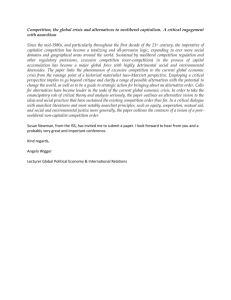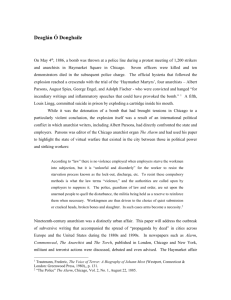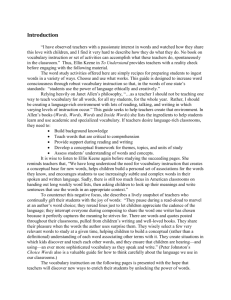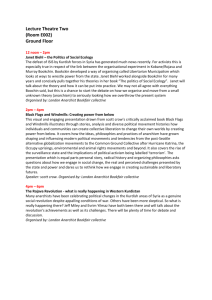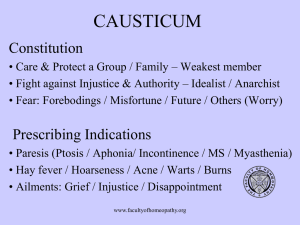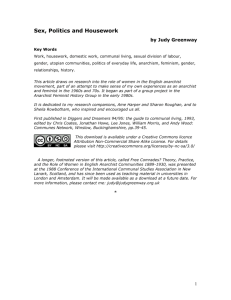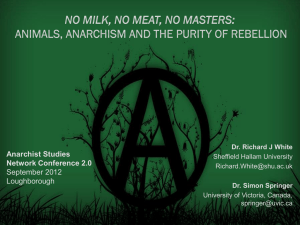The role of work in anarchist utopias
advertisement
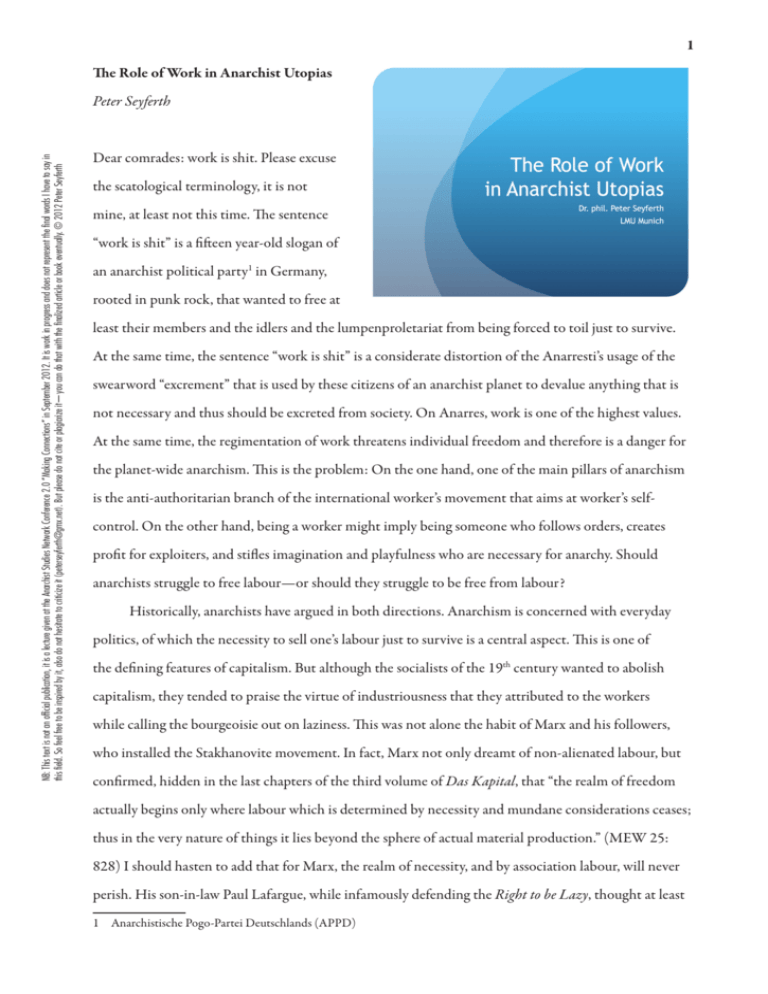
The Role of Work in Anarchist Utopias NB: This text is not an official publication, it is a lecture given at the Anarchist Studies Network Conference 2.0 “Making Connections” in September 2012. It is work in progress and does not represent the final words I have to say in this field. So feel free to be inspired by it, also do not hesitate to criticize it (peterseyferth@gmx.net). But please do not cite or plagiarize it—you can do that with the finalized article or book eventually. © 2012 Peter Seyferth Peter Seyferth Dear comrades: work is shit. Please excuse the scatological terminology, it is not mine, at least not this time. The sentence “work is shit” is a fifteen year-old slogan of an anarchist political party in Germany, rooted in punk rock, that wanted to free at least their members and the idlers and the lumpenproletariat from being forced to toil just to survive. At the same time, the sentence “work is shit” is a considerate distortion of the Anarresti’s usage of the swearword “excrement” that is used by these citizens of an anarchist planet to devalue anything that is not necessary and thus should be excreted from society. On Anarres, work is one of the highest values. At the same time, the regimentation of work threatens individual freedom and therefore is a danger for the planet-wide anarchism. This is the problem: On the one hand, one of the main pillars of anarchism is the anti-authoritarian branch of the international worker’s movement that aims at worker’s selfcontrol. On the other hand, being a worker might imply being someone who follows orders, creates profit for exploiters, and stifles imagination and playfulness who are necessary for anarchy. Should anarchists struggle to free labour—or should they struggle to be free from labour? Historically, anarchists have argued in both directions. Anarchism is concerned with everyday politics, of which the necessity to sell one’s labour just to survive is a central aspect. This is one of the defining features of capitalism. But although the socialists of the 19th century wanted to abolish capitalism, they tended to praise the virtue of industriousness that they attributed to the workers while calling the bourgeoisie out on laziness. This was not alone the habit of Marx and his followers, who installed the Stakhanovite movement. In fact, Marx not only dreamt of non-alienated labour, but confirmed, hidden in the last chapters of the third volume of Das Kapital, that “the realm of freedom actually begins only where labour which is determined by necessity and mundane considerations ceases; thus in the very nature of things it lies beyond the sphere of actual material production.” (MEW 25: 828) I should hasten to add that for Marx, the realm of necessity, and by association labour, will never perish. His son-in-law Paul Lafargue, while infamously defending the Right to be Lazy, thought at least Anarchistische Pogo-Partei Deutschlands (APPD) some work was necessary (3 hours a day) and attacked the zero-work attitude of the NB: This text is not an official publication, it is a lecture given at the Anarchist Studies Network Conference 2.0 “Making Connections” in September 2012. It is work in progress and does not represent the final words I have to say in this field. So feel free to be inspired by it, also do not hesitate to criticize it (peterseyferth@gmx.net). But please do not cite or plagiarize it—you can do that with the finalized article or book eventually. © 2012 Peter Seyferth bourgeoisie. The assertion that work has at least some inherent value can also be found in 19th century anarchist writings. Michael Bakunin, for example, deemed manual labour a source of morality that should be customarily enforced on those “social thieves” who are lazy. Not too far from Marx, Peter Kropotkin also thought of some work as necessary, so it should at least be distributed justly and organized humanly. In the 20th century, some anarchists like Paul Goodman still were ambivalent towards forced labour, but work was attacked much more fiercely than ever before. While the official slogans and politics of the CNT during the Spanish Civil War were promoting an ethos of hard work, sobriety, and industriousness, the actual workers (including the CNT’s card holders) fought against increased productivity by loitering, absenteeism, and threats against overfulfillers, as Michael Seidman has shown. Later, Murray Bookchin hoped for a liberatory technology to free the humans from toil. Bob Black, on the other hand, did not bank on machines but advised to transform work into play so it is fun to do. And in their early writings at the beginning of the 21st century, the CrimethInc. collective seemed to prefer to just drop out and walk away from the workplaces. What can I add to these positions? Firstly, I will recall some of the reasons to reject work, placing myself on the antiproductivist end of the anarchist spectrum. And secondly, I will show you an incomplete table of anarchist utopias and their depiction of labour in a really free world. I will discuss Ursula K. Le Guin’s The Dispossessed, her Always Coming Home, Starhawk’s Fifth Sacred Thing, and Chris Carlsson’s After the Deluge, which, thirdly, amount to mixed findings. I. Work destroys our bodies. This is obvious for miners and assembly-line workers, but white-collar jobs NB: This text is not an official publication, it is a lecture given at the Anarchist Studies Network Conference 2.0 “Making Connections” in September 2012. It is work in progress and does not represent the final words I have to say in this field. So feel free to be inspired by it, also do not hesitate to criticize it (peterseyferth@gmx.net). But please do not cite or plagiarize it—you can do that with the finalized article or book eventually. © 2012 Peter Seyferth can cause carpal tunnel syndromes and back trouble, too. Each year two million people die at work, says the United Nations; Tom Hodgkinson says that this equals a daily 9/11 tragedy, but no government declares a war on work. Bob Black additionally points to all the deaths and injuries caused in car accidents on the way to and fro the workplace, or while looking for work, or while trying to forget work. Many drug and alcohol related deaths as well as heart attacks fall into this category, too. Work destroys our minds. Already Paul Lafargue lamented about the stupidity at the workplaces. Today we have immaterial work that requires social, emotional, and technical intelligence, but our minds are still under attack by burnout, depression, and drug abuse. Work destroys our wealth. Have you ever heard of someone becoming rich by just working hard enough? No, you have heard about the working poor. This is not new; Lafargue has observed it and put it in eloquent words: “Work, work, proletarians, to increase social wealth and your individual poverty; work, work, in order that becoming poorer, you may have more reason to work and become miserable. Such is the inexorable law of capitalist production.” (2012 (The Anarchist Library), p. 11) Work is not the natural way to get the goods you need. In fact, it was implemented by force, by enclosing and destroying the commons, which have been the natural way to get goods. To make you a worker, we have to make you poor in the first place; and we must not let you get rich and independent or else we loose NB: This text is not an official publication, it is a lecture given at the Anarchist Studies Network Conference 2.0 “Making Connections” in September 2012. It is work in progress and does not represent the final words I have to say in this field. So feel free to be inspired by it, also do not hesitate to criticize it (peterseyferth@gmx.net). But please do not cite or plagiarize it—you can do that with the finalized article or book eventually. © 2012 Peter Seyferth your servitude. Of course, labour does make some people rich—those people who manage to grab the surplus value of other people’s labour. This is an especially despicable kind of work, but it is questionable if it suffices to abolish only the profitable jobs and to slog on with the impoverishing toil. Work destroys our morality. A work ethics is self-contradictory, since there is nothing ethical in work itself. Here I can quote Bertrand Russell, who asserts “that there is far too much work done in the world, that immense harm is caused by the belief that work is virtuous, and that what needs to be preached in modern industrial countries is quite different from what always has been preached.” But why is work immoral? Because it degrades the human by turning them into a means to an end, and, worse, by turning them into a commodity. Work is a doing that is enforced by external pressures. Since Aristotle we know that doing something can be virtuous if this conduct has intrinsic value, which work, per definition as wage-labour, has not. But we have to be careful with Aristotle and other ancient authors like Cicero or the antique-like Nietzsche. They all despised work because it should be done by slaves, not by the aristocracy. This is immoral, too, as long as morality has anything to do with fairness and equality. This leads over to political reasons for abolishing work. Work destroys our freedom. It is one of the most efficient instruments of power because it does not look like violence but seems to feed the people. While work produces products we might need or want, it also produces subjects; I mean subjectivities of being one who follows the orders of boss or punter. Yes I dear to say it: All workers are whores, they sell their bodies and time and skills and do what pleases the payer. Getting used to work means getting used to subservience, to surveillance, and to being part of a hierarchical pyramid. The refusal of work, on the other hand, damages the state, reduces profits, threatens the whole economic order and might even end the energy crisis and the destruction of the environment; this is at least what Bob Black hopes. Work is already dying. Work is shit, but even if we suddenly realized that work was beautiful and emancipatory, we would have to start thinking about a post-work society. Just look at the unemployment rates. Of course there could emerge a post-capitalist society where we all have to toil again, e.g. when new aristocrats succeed in establishing a “New Feudalism”, as Jello Biafra and other cool people have warned for some years. But let’s now look at anarchist societies that somehow have to handle the problem of work. NB: This text is not an official publication, it is a lecture given at the Anarchist Studies Network Conference 2.0 “Making Connections” in September 2012. It is work in progress and does not represent the final words I have to say in this field. So feel free to be inspired by it, also do not hesitate to criticize it (peterseyferth@gmx.net). But please do not cite or plagiarize it—you can do that with the finalized article or book eventually. © 2012 Peter Seyferth II. Here is a table of four noteworthy anarchist utopias of the last four decades. They are all so-called openended or critical utopias, i.e. they do not try to provide a flawless blueprint but just to illustrate a society that, while being considerably better than ours, still has faults, is questioned by their inhabitants, and thus is quite realistic while at the same time initiating creative utopian thinking in the reader. We start with Ursula K. Le Guin’s classic The Dispossessed, published in 1974. In this book we find an anarchist planet, Anarres, inhabited for more than 100 years by the descendants of failed anarchist revolutionaries who were driven to exile from their home planet Urras. Already before the revolution, the anarchists were of the syndicalist flavour. On top of this, Le Guin was inspired by the writings of Peter Kropotkin and Paul Goodman, who both are proponents of work, if not of too much of it. Not surprisingly, the whole social structure on Anarres is grounded on labour. Everything from mining via arts to marital activities is organized in syndicates. This transforms almost all activities into some kind of work that one should light-heartedly relinquish when a more useful work has to be done. The Anarresti have a strict, almost Protestant, work ethic, and they are ready to leave partners and children behind to enforest the desert and what not. Everybody has to work hard for a living, because the planet is so dry and barren. Not surprisingly, efficiency is valued high. The Anarresti society is an industrial society that overexploits their natural resources. Surprisingly, the population grows exponentially, faster than NB: This text is not an official publication, it is a lecture given at the Anarchist Studies Network Conference 2.0 “Making Connections” in September 2012. It is work in progress and does not represent the final words I have to say in this field. So feel free to be inspired by it, also do not hesitate to criticize it (peterseyferth@gmx.net). But please do not cite or plagiarize it—you can do that with the finalized article or book eventually. © 2012 Peter Seyferth in India in our times. This puts all living things on this planet under stress, especially the humans. As anarcho-syndicalists, the Anarresti have no problem in trying to achieve solutions by organizations. So they found the “Production and Distribution Coordination”, the PDC, an institution made not to govern people but to manage everything connected with products and so to ensure efficiency. Since workers are connected with products, too, and since institutions tend to become bureaucratic, the PDC becomes a hidden government that rules through work assignments and social control. Sure, there are also the Nuchnibi, as they call the idlers. But often they are not welcome. All in all, for a lazy anti-productivist like me, Anarres is not a fun place to stay. Not surprisingly, SF author Ken MacLeod has called The Dispossessed “a book which has probably put more people off Anarchism than any other. It presents a dour vision of Anarchist Communism: something like a particularly fanatical kibbutz or Spanish Civil War collective.” Le Guin herself was not content with her first utopia, so she wrote a second one, Always Coming Home, which was published in 1985. The book is set in a future northern California, probably several thousand years from now. There live the Kesh people in the Na Valley. Critics do tend to not like this utopia and to dismiss it as “a naively regressive picture of a sort of Happy Hunting Ground for fake Indians”, but this is undue. Sure, the society is structured in a traditional manner, inspired by culture anthropology. They have complicated degrees of family-relationships, exogamous totem-clans, rituals, festivals, myths. But Le Guin was also inspired by Murray Bookchin’s Ecology of Freedom, which advises to abolish toil and to favour very high-tech machinery. The Kesh do seldom work hard, and they seldom use high technology, they can afford to play stone age. This is partly explained by their culture, which is non-competitive most of the time (with the exception of insult contests at one of their festivals). The culture also devalues having many things or being nuts about personal achievements. NB: This text is not an official publication, it is a lecture given at the Anarchist Studies Network Conference 2.0 “Making Connections” in September 2012. It is work in progress and does not represent the final words I have to say in this field. So feel free to be inspired by it, also do not hesitate to criticize it (peterseyferth@gmx.net). But please do not cite or plagiarize it—you can do that with the finalized article or book eventually. © 2012 Peter Seyferth The Kesh think they have much time, they like long names and slow traffic, and they are so lazy that they eat without knifes or forks just to reduce washing up. This would not be possible if they lived in a desert like the Anarresti. The Kesh live in a rich natural environment and are part-time gardeners and part-time gatherers (they also sometimes hunt, yet find this kind of childish). Because they live in an “original affluent society”, to borrow the term from Marshall Sahlins, rejecting a government disguised as efficiency is easy to them. The Na Valley is no paradise, though. The Kesh have to struggle with the poison and industrial waste we left for them, they are threatened by war-mongering neighbours, and they have to very strictly control their population size to maintain the lazy lifestyle. As an antiproductivist and idler, I would like to take a vacation in this bucolic society; but I am not enough a primitivist to want to permanently live there. Wait! “There” are the next two utopias, too. We will not leave future Northern California, we will just change the fantasies about how this part of the world might one day look like. Let us turn to Starhawk’s The Fifth Sacred Thing, published in 1993. This is certainly an esoteric book, and it is certainly an ecotopian book, but I am not so sure if it is actually an anarchist book. In it, a possible San Francisco of the year 2048 is portrayed. This city chose it’s own way when some women started to rip open the streets and plant gardens instead, as a resistance action against ecologically and spiritually destructive fascists. Since then countless councils, committees, and collectives have sprung up, now substituting more hierarchical legislative, executive and juridical bodies. Decisions are made by facilitated consensus, taking into account the needs of the holy elements fire, earth, air, and water, who are represented by individuals in trance. The politics are mainly nonviolent and aimed at healing the environment. There are persistent quarrels about violence, about means and ends, about vegetarianism, and about equal pay for everyone. This all sounds quite anarchistic. But the economy uses money to allocate goods; workgroups act as firms and have to sell their products at a market; there is some redistribution, but accumulation of wealth is possible and accepted, too. Most professions are organized in guilds who form a second decision making structure beside the neighbourhood councils and the city NB: This text is not an official publication, it is a lecture given at the Anarchist Studies Network Conference 2.0 “Making Connections” in September 2012. It is work in progress and does not represent the final words I have to say in this field. So feel free to be inspired by it, also do not hesitate to criticize it (peterseyferth@gmx.net). But please do not cite or plagiarize it—you can do that with the finalized article or book eventually. © 2012 Peter Seyferth council. In this hodgepodge system, spirituality and labour seem to be the frame for orientation. All work, including housework and child-rearing, is paid equal per hour, with the exception of musicians and healers, who receive payment without counting their work hours. Some work assignments are indentured, e.g. some hours of cleaning toxic waste each year. Aside from that, you can choose whatever profession you like. It is also possible to not work, because an unconditional basic income secures basic needs. But it is assumed that wanting to work is normal, only ill people do not and thus have to be healed. If one does not like their job, another job is offered. If one just refuses to work, they are isolated and shamed and sent to a psychologist. So while on the first look, San Francisco is a hippie commune, it also has a strict work ethic and uses social pressure to activate the citizens. It has to be added that The Fifth Sacred Thing is told from three perspectives, of which two are notorious martyrs of toilsomeness. Especially the healer Madrone works until being completely exhausted and passing out again and again, and the main motivation of the protagonists seems to be their usefulness to the community. So the book has clearly an achievement-oriented bias, all spirituality aside. It does make sense to contrast this San Francisco with the 2157 San Francisco Chris Carlsson described in his After the Deluge, published in 2004. Here we have, again, a hodgepodge of councils and committees, partly with the exact same names as in Starhawk’s novel. There are eternal controversies about how to defend the city against possible military threats, about which streets should be left open to bicycles and which should be turned into gardens, about how much work everybody should at least carry out every year: 60 or 30 hours. Not in a week. In a year. In the rest of the US, it is common to enter these Annuals, as the yearly workload is called, into a workbook, but in San Francisco there is a very generous feeling of abundance and nobody cares about workbooks. Posters and friends will eventually ask you to do your Annuals, but you can very easily refuse to do so. You will nonetheless get all the goods you want at the freestores, borrow bikes at the velomes, eat at public kitchens, and smoke the buds you find everywhere. There is no money or credit system. Of course somehow the goods have to be produced. There is a sophisticated labour system that distinguishes NB: This text is not an official publication, it is a lecture given at the Anarchist Studies Network Conference 2.0 “Making Connections” in September 2012. It is work in progress and does not represent the final words I have to say in this field. So feel free to be inspired by it, also do not hesitate to criticize it (peterseyferth@gmx.net). But please do not cite or plagiarize it—you can do that with the finalized article or book eventually. © 2012 Peter Seyferth between those doing their Annuals, mostly stupid dirt work, and the Tryouts, the Apprentices, and the Lifers. Tryouts try out a job for a few months and so learn basic skills. Many artisans and factories take pains to appear attractive to get enough Tryouts. After that, an Apprenticeship is a commitment for several years, and Lifers stick to one job for their entire life. Although equality in decision making is of high value politically, at the workplace the Lifers and the Tryouts have a fundamental conflict: The Lifers are experts in their fields and thusly annoyed by the ineptitude of the Tryouts, while the latter hate the bossiness of the former. But why would anyone want to be a Tryout, an Apprentice, or a Lifer anyway? The story is told from the perspective of two young men, both discontented with their daily activities. One of them eventually finds something he really wants to do, which is a good thing when he needs to be distracted from lovesickness, whereas the other one cannot be satisfied by what San Francisco has to offer him; in the end he will leave to become a terrorist. Here we have a dystopian outsider we learn to understand, and to despise. Now we have created a crammed table. What can we do with it? 10 III. This table might help us to get an overview of how anarchist societies could be, how they are in the NB: This text is not an official publication, it is a lecture given at the Anarchist Studies Network Conference 2.0 “Making Connections” in September 2012. It is work in progress and does not represent the final words I have to say in this field. So feel free to be inspired by it, also do not hesitate to criticize it (peterseyferth@gmx.net). But please do not cite or plagiarize it—you can do that with the finalized article or book eventually. © 2012 Peter Seyferth fantasies of a few authors. This table is by no means complete. We could add William Morris’s News from Nowhere, where work is seen as something beautiful as long as it is done together with and for the community, or we could add several of Iain M. Banks’s Culture books where work seems to be unnecessary because of sophisticated technology. Different anarchist utopias paint wildly different pictures of how work would be organized or abolished in a non-hierarchical, non-capitalist society. After the Deluge is a utopia that focuses on work, whereas Starhawk’s The Fifth Sacred Thing focuses on spirituality, resulting in some inconsistencies in the depicted labour system. Le Guin’s Always Coming Home focuses on family relationships, but has the themes of spirituality and work in it, too. Her The Dispossessed discusses a harsh work ethic and displays one anarchist’s discontent with it. Starhawk’s work ethic seems to be even harsher, since there does not seem to be much unhappiness with it, although very unhappy things happen in her book. It is not possible to infer from the book to the author. But it is possible to infer from our reactions to the books to our evaluation of hard work. Utopias can help us to find out what we are dreaming of, what we really want. If you had to swap places with one of the utopians: whom would you choose? But I do not think utopia is just wishful thinking—on the contrary, utopia is a device for critically evaluating political and social goals, which is why utopias have always to be seen in the utopian tradition, that means each utopia is one of many, no one is the perfect, ultimate one. Therefore it is a good thing that the depicted work systems have such a wide variety. Reading one utopia might result in thinking: aha, so it must be. If it is The Dispossessed we read, we might conclude that anarchism is tough and destitute, even if it is better than most social positions capitalism has to offer. But if we read many utopias, we learn something completely different: to open our minds to many options. We learn to build worlds in our head, which I think is a prerequisite for building a new world in the shell of the old. Readers of utopias recognize the complexities of the social subsystems. The production of goods and services is one such subsystem, and it influences both individual happiness and the freedom of the whole community. You can live through this and experience it yourself. I experienced that a strict work ethic is inhibiting happiness and freedom. So I dare to say: work is shit. But I kindly ask you to experience anarchist utopias for yourself and make your own conclusions. After my lecture, Ruth Kinna pointed me to Morris’ three categories: exploited work (which is bad)—art (which is open to self-fashioning, as well as the making of things)—idleness (which is bad). My propositions obviously need refinement! NB: This text is not an official publication, it is a lecture given at the Anarchist Studies Network Conference 2.0 “Making Connections” in September 2012. It is work in progress and does not represent the final words I have to say in this field. So feel free to be inspired by it, also do not hesitate to criticize it (peterseyferth@gmx.net). But please do not cite or plagiarize it—you can do that with the finalized article or book eventually. © 2012 Peter Seyferth 11
